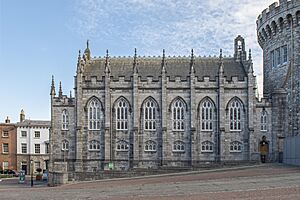Chapel Royal, Dublin facts for kids
Quick facts for kids The Chapel Royal |
|
|---|---|
|
An Seipeal Rioga
|
|

A view of the exterior
|
|
| Religion | |
| Affiliation | Church of Ireland (1814–1922) Roman Catholic (1943–1982) None (1922–1943; 1983–present) |
| Province | Leinster |
| Year consecrated | 1814 |
| Status | Museum |
| Location | |
| Location | Dublin Castle, Dublin, Ireland |
| Architecture | |
| Architect(s) | Francis Johnston |
| Architectural style | Gothic revival |
The Chapel Royal is a beautiful old chapel located inside Dublin Castle in Ireland. It was built in the 1800s in a style called Gothic revival, which looks like old medieval churches.
For over a hundred years, from 1814 to 1922, it was the official chapel for the Lord Lieutenant of Ireland. This person was the King or Queen's representative in Ireland. After Ireland became independent in 1922, the chapel was no longer used for this purpose.
Later, in 1943, it became a Catholic place of worship and was renamed the Church of the Most Holy Trinity. However, it has not been used for regular church services since 1983. Today, it is part of the Dublin Castle complex and is sometimes used for special events.
Contents
Building the Chapel Royal
The Chapel Royal was designed by Francis Johnston. He was a very important architect in Ireland in the early 1800s. The inside of the chapel is considered one of the best examples of Gothic revival design in Ireland.
Before this chapel, there was an older church on the same spot. It had problems because it was built on soft ground near the castle's old moat. To fix this, the new Chapel Royal was built with a special timber (wood) frame. This made it as light as possible.
It took seven years to build the chapel, partly because of the difficult ground. Another reason was how fancy and detailed the inside was. The first stone was laid on February 15, 1807. The chapel finally opened on Christmas Day, 1814.
The Lord Lieutenant at the time, Lord Whitworth, helped with the chapel's design. He gave the large stained-glass window above the altar. He bought it in Paris, and people say it originally came from Russia. The rest of the window was made by a Mr. Bradley in Dublin.
The ceiling inside the chapel was decorated by George Stapleton. He was a famous artist who worked with plaster. Sculptors Edward Smyth and his son John Smyth carved the larger figures. For example, above the main window, there are three life-size figures. They represent Faith, Hope, and Charity. All the columns and arches inside look like stone, but they are actually made of wood. They were painted to look like real stone.
The outside of the chapel is covered in a thin layer of fine limestone. It is famous for having over 90 carved heads. These heads include important Irish figures like Brian Boru, St. Patrick, and Jonathan Swift. Edward and John Smyth carved these detailed heads.
Interesting Historical Details

This chapel was the third one built at Dublin Castle since medieval times. It was the second chapel to be built in this exact spot. Before the Chapel Royal was finished, the Lord Lieutenant and his staff sometimes went to St. Werburgh's Church nearby. The huge pulpit (a raised stand for a speaker) that used to be in the Chapel Royal is now in St. Werburgh's.
There is a secret passage behind one of the galleries. This passage leads to the bedrooms in the State Apartments. The Lord Lieutenant and his guests used this passage when they stayed at the castle. The Lord Lieutenant had his own special seat, like a throne, in the middle of the right-hand gallery. The bishop's seat was directly across from him.
The organ case, which holds the organ, was built in 1857. It housed a new organ by William Telford. Later, in 1900, a new organ was put into the same case. The case was fixed up in 2008, but the organ itself no longer works. Its pipes and parts have been taken out.
When a Lord Lieutenant left office, their family crest (coat of arms) was carved on the gallery. When there was no more space on the gallery, the crests were placed in the chapel's windows. It's interesting that the last window was filled by the very last Lord Lieutenant, Lord FitzAlan of Derwent.
The Chapel Today
In 1943, the Chapel Royal became a Roman Catholic military church. It was renamed the Church of the Most Holy Trinity. The beautiful Stations of the Cross inside were carved by monks from Glenstal Abbey in 1946.
However, the building started having structural problems in the early 1980s. This caused it to close. The chapel was later restored and reopened in the early 1990s. Even though it's been fixed, it is not used for regular church services anymore. Instead, it is sometimes used for concerts and other special events.
The Chapel Royal has also been used for filming. It appeared in the TV series The Tudors for scenes, including the trial of Thomas More. In April 2024, the chapel and Dublin Castle were closed for a week. This was for filming Enola Holmes 3, starring Netflix actress Millie Bobbie Brown.
Images for kids
See also
 In Spanish: Capilla Real (Castillo de Dublín) para niños
In Spanish: Capilla Real (Castillo de Dublín) para niños





